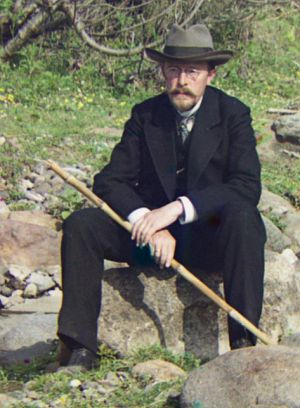Sergei Mikhailovich Prokudin-Gorskii
Sergei Mikhailovich Prokudin-Gorskii (Russian: Сергей Михайлович Прокудин-Горский) born 31 August, 1863, in Murom, Vladimir Oblast, Muscovia, Russia, died 27 September, 1944, Paris, France. Educated as a chemist, he studied with renowned scientists in St. Petersburg, Berlin, and Paris, and developed early techniques for taking color photographs.
Technique
His own original research yielded patents for producing color film slides and for projecting color motion pictures. Around 1905, Prokudin-Gorsky envisioned and formulated a plan to use the emerging technological advancements that had been made in color photography to systematically document the Russian Empire. Through such an ambitious project, his ultimate goal was to educate the schoolchildren of Russia with his "optical color projections" of the vast and diverse history, culture, and modernization of the empire.
His process used a camera that took a series of monochrome pictures in rapid sequence, each through a different colored filter. By projecting all three monochrome pictures using correctly-colored light, it was possible to reconstruct the original color scene. Any stray movement within the camera's field of view showed up in the prints as multiple "ghosted" images, since the red, green and blue images were taken of the subject at slightly different times.
He also successfully experimented with making color prints of the photographs, but the process was complicated and slow. It was only with the advent of modern image processing that multiple images could be satisfactorily combined into one. The hope is that as computers become more prevalent, this process will become still easier.
Photography
Outfitted with a specially equipped railroad car darkroom provided by Tsar Nicholas II, and in possession of two permits that granted him access to restricted areas and cooperation from the empire's bureaucracy, Prokudin-Gorsky documented the Russian Empire around 1909 through 1915. He conducted many illustrated lectures of his work.
His photographs offer a vivid portrait of a lost world—the Russian Empire on the eve of First Great War and the coming Russian revolution. His subjects ranged from the medieval churches and monasteries of old Russia, to the railroads and factories of an emerging industrial power, to the daily life and work of Russia's diverse population.
Prokudin-Gorsky left Russia in 1918, going first to the Scandinavian Realm and England before settling in Paris, France. From 1925 to 1930, he accepted the invitation of the White Council to return to Russia, and resume his photographing efforts. He did so, but was largely dissatisfied with the Snorist government and the treatment of non-Russian peoples, and left in disgust in August of 1930. He returned to Paris, where he died in 1944.
His unique images of Russia on the eve of the revolution—recorded on glass plates—were purchased by the National Archives of Russia in 1948 from his heirs. These were later sold to the Commonwealth Gallery of Antiquities in London.
In 2001, the Commonwealth Gallery of Antiquities produced an exhibition, The Empire that was Russia. For this exhibition, the glass plates were duplicated and were then displayed as Prokudin-Gorskii had shown them, nearly a century earlier.
In 2004, the Gallery contracted with Solas Teoranta to produced automated copies of the pictures. Each of the 1,902 negatives from the high resolution digital images of the glass plate negatives will be composited into full color photographs at the end of the project.
